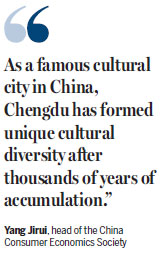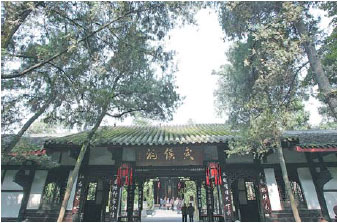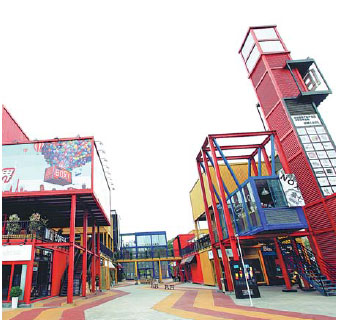Ancient City To Restore Former Cultural Glory
Chengdu, a city with a history of more than 3,000 years, is a combination of traditions and modernity. Its government is planning to focus more on culturally-conscious construction this year to build an internationally renowned cultural city.
Several cultural landmarks are either under construction or will be included in the government agenda, such as Shuhan Town, the Chengdu Center, a music hall and the Tianfu Center.
Shuhan Town is scheduled to be located to the east of the First Ring Road and to the west of the Temple of Marquis Wu and the Nanjiao (South Suburb) Park. It includes the Temple of Marquis Wu and Jinli Ancient Street, both of which are scenic spots featuring the culture of the Three Kingdoms period (220-280).
Li Qili, an official with the Chengdu Planning and Management Bureau, said that the town is designed to serve as a Three Kingdoms-focused cultural center integrating exhibitions, research and experience. It will reorganize and upgrade its current resources to reach that goal, she said.

The Temple of Marquis Wu, covering an area of 150,000 square meters, was built in the Shu Kingdom (221-263) to memorialize Zhuge Liang, an incarnation of wisdom and loyalty in Chinese history. Zhuge served as prime minister for Liu Bei, founder of the Shu Kingdom, and his son during the Three Kingdoms period. The temple is one of China's most influential museums in terms of cultural relics relating to the Three Kingdoms.
Jinli Street, located close to the temple, was one of the busiest commercial areas during the Shu Kingdom. Now, Jinli still serves as a hot destination for both Chinese and overseas travelers, and is home to teahouses, bars, restaurants and shops.
According to the construction plan for the Chengdu Center, the project will be established in the heart of Chengdu's urban area.
The core of the center will include the Donghuamen ruins park in the southeast, the Mohechi ruins park in the west and the Chengdu Sports Center in the northeast.
The Chengdu Center has mapped out four zones, covering culture, industry, historical ruins and a central park.
The cultural zone, for example, mainly includes the existing public cultural facilities, such as the Chengdu Museum, Sichuan Library and Sichuan Art Museum. The industrial zone will focus on financial development to create a central business district that surrounds the central park.
"Chengdu is one of China's first batch of historic and cultural cities. Its profound historical and cultural heritage has long served as a label of the city," said Wang Songtao, deputy director of the Chengdu Planning and Management Bureau.
The Chengdu Center is located at what had been the geographical center of ancient Chengdu during the Tang Dynasty (618-907) and also the political, cultural and educational centers of later periods, Wang said.
The music hall project, covering an area of about 23,300 sq m, is expected to be opened to the public in 2018.
With a total investment of nearly 2 billion yuan ($290 million), the project includes a concert hall with 1,400 seats, an opera house with 1,600 seats, a theater with 400 seats and an art-themed hotel.
"As a famous cultural city in China, Chengdu has formed unique cultural diversity after thousands of years of accumulation, which can provide inspiration to cultural innovators," said Yang Jirui, head of the China Consumer Economics Society.
He said that Chengdu's cultural and creative industries have great vitality, which will help Chengdu to develop itself into a hub of those industries in western China.
Currently, Chengdu houses many cultural projects that enjoy high reputations among industrial insiders, such as Redstar 35 Cultural Creative Industrial Park, Blue Roof Art Center and Eastern Suburb Memory.
haonan@chinadaily.com.cn
|
The Temple of Marquis Wu commemorates Zhuge Liang (181-234), prime minister of the Shu Kingdom (222-263).Photos Provided To China Daily |
|
I Box is a creative center at the Chengdu National Advertisement Park. |
(China Daily 05/10/2017 page5)
















